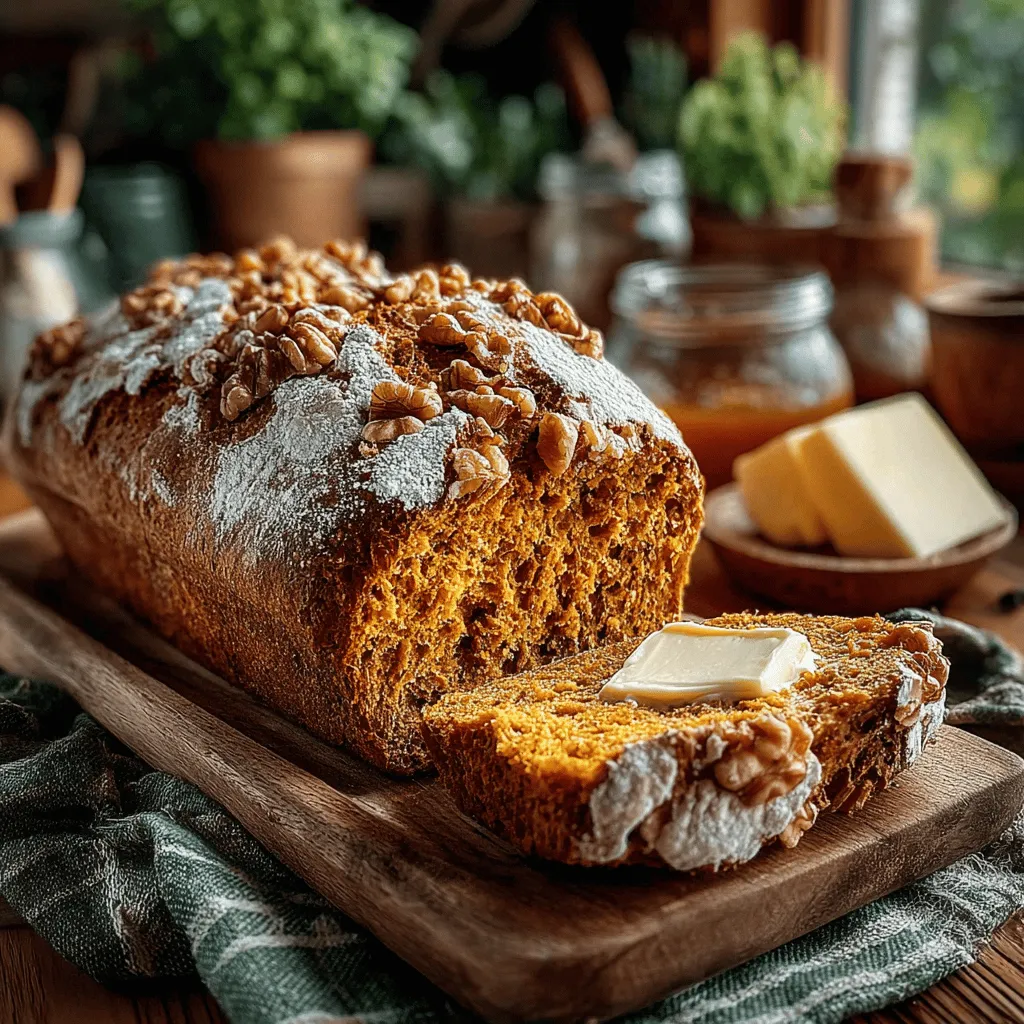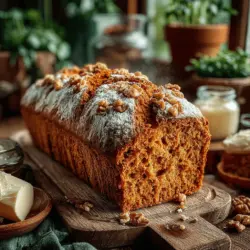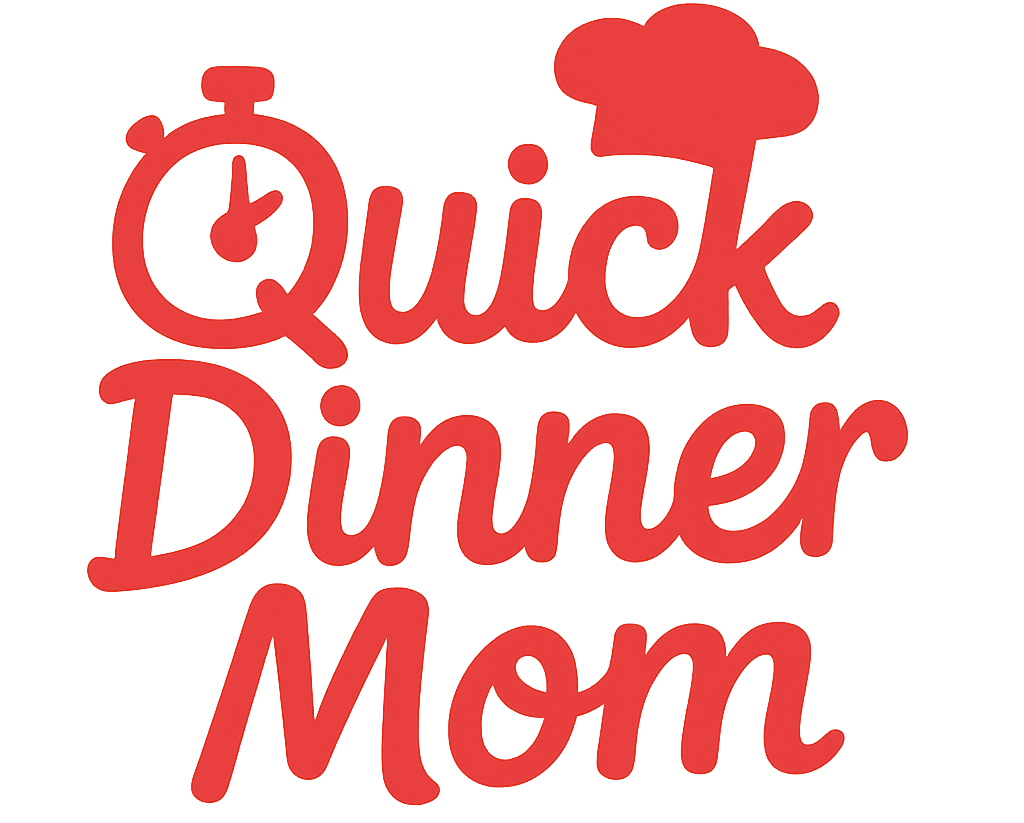Autumn Harvest Pumpkin & Walnut Spelt Bread Recipe
As the leaves turn golden and the air becomes crisp, we find ourselves yearning for the comforting flavors of autumn. One delightful way to indulge in this seasonal bounty is through the creation of a warm and inviting loaf of Autumn Harvest Pumpkin & Walnut Spelt Bread. This recipe marries the earthy sweetness of pumpkin with the rich, nutty flavor of walnuts, all enveloped in the wholesome goodness of spelt flour. Not only does this bread celebrate the harvest season, but it also offers a nourishing option that’s perfect for breakfast, snacks, or as an accompaniment to your favorite autumn soups.
Spelt, an ancient grain that has made a comeback in recent years, is at the heart of this recipe. Known for its slightly nutty flavor and chewy texture, spelt flour brings depth to this bread while offering a host of nutritional benefits. Rich in dietary fiber, protein, and essential nutrients, spelt flour can be a fantastic alternative to conventional wheat flour, making your bread not just delicious but also healthier.
Pumpkin puree, a staple of autumn baking, not only adds a vibrant color but also infuses the bread with moisture and natural sweetness. This versatile ingredient is packed with vitamins A and C, as well as antioxidants that support overall health. Whether you choose to use canned pumpkin or make your own from fresh pumpkins, the flavor it imparts is distinctly autumnal and comforting.
Walnuts offer a delightful crunch and a boost of nutrition, being an excellent source of omega-3 fatty acids, which support heart health and brain function. Their rich flavor and texture complement the softness of the bread and enhance the overall eating experience.
As you embark on the journey of making this Autumn Harvest Pumpkin & Walnut Spelt Bread, you’ll find the process both rewarding and enjoyable. This recipe invites you to slow down and savor the act of baking, allowing the aromas of spices and toasted nuts to fill your kitchen. Let’s dive into an exploration of the ingredients and the steps that will lead to a beautifully baked loaf.
Understanding the Ingredients
Spelt Flour
Spelt flour is derived from an ancient variety of wheat and has gained popularity among health-conscious bakers due to its nutritional profile. Unlike regular wheat flour, spelt flour contains more protein and fiber, making it a heartier option for bread-making. Its unique composition includes a range of vitamins and minerals, such as magnesium, phosphorus, and B vitamins, which are essential for maintaining energy levels and supporting metabolic processes.
Baking with spelt flour can yield results that are both light and flavorful. Its gluten structure is more delicate than that of conventional wheat, which means that it often requires less kneading and offers a tender crumb. This quality makes spelt flour an excellent choice for those looking to create a rustic bread that’s easy to digest while still providing the satisfaction of a traditional loaf.
Pumpkin Puree
When it comes to adding moisture and flavor to baked goods, pumpkin puree is hard to beat. It’s a rich source of beta-carotene, which the body converts into vitamin A, supporting eye health and boosting the immune system. Additionally, pumpkin is low in calories and high in fiber, making it a nutritious addition to any bread recipe.
There are two primary options for pumpkin puree: canned and homemade. Canned pumpkin puree is convenient and offers consistent results, while homemade puree allows for a fresher flavor. To make your own, simply roast fresh pumpkin until tender, scoop out the flesh, and blend until smooth. Regardless of your choice, the incorporation of pumpkin in this bread recipe will provide a delightful sweetness and a vibrant color that epitomizes the essence of autumn.
Walnuts
Walnuts are not only a delicious addition to this recipe, but they also bring a wealth of health benefits. Rich in omega-3 fatty acids, walnuts are known for their anti-inflammatory properties and their role in promoting brain health. These nuts are also packed with antioxidants, vitamins, and minerals, making them a powerhouse of nutrition.
In terms of flavor and texture, walnuts add a delightful crunch to the soft, tender crumb of the bread. Their slightly bitter notes provide a perfect contrast to the sweetness of the pumpkin and the warmth of the spices, creating a well-rounded flavor profile that is sure to please your palate.
Sweeteners: Brown Sugar vs. Honey/Maple Syrup
When it comes to sweetening this bread, you have options. Brown sugar offers a deep, molasses-like flavor that enhances the richness of the pumpkin and walnuts, contributing to a beautifully caramelized crust. On the other hand, natural sweeteners like honey or maple syrup can provide a different dimension of flavor while also adding moisture to the bread.
Using honey or maple syrup can impart subtle floral or woody notes, respectively, which can elevate the overall taste experience. Additionally, both sweeteners have their own health benefits, including natural antioxidants and lower glycemic indices compared to refined sugars. Ultimately, the choice between brown sugar and natural sweeteners depends on your personal preference and the flavor profile you wish to achieve in your Autumn Harvest Pumpkin & Walnut Spelt Bread.
Step-by-Step Guide to Making Autumn Harvest Pumpkin & Walnut Spelt Bread
Activating the Yeast
The first step in creating your Autumn Harvest Pumpkin & Walnut Spelt Bread involves activating the yeast. This is a crucial process that ensures your bread rises properly, resulting in a light and airy texture. Begin by measuring out warm water (around 110°F or 43°C) and adding it to a mixing bowl. Sprinkle the yeast over the water, allowing it to dissolve for a few minutes. You should see small bubbles forming, indicating that the yeast is alive and ready to work its magic. If there are no bubbles after five minutes, it may be best to start over with fresh yeast.
Mixing the Wet Ingredients
Once your yeast is activated, it’s time to mix the wet ingredients. In a separate bowl, combine the pumpkin puree with your choice of sweetener, whether that be brown sugar, honey, or maple syrup. Mix until well blended, and then add the activated yeast mixture. This combination forms the base of your bread and sets the stage for the flavors to meld together.
To achieve a smooth mixture, ensure that the pumpkin puree is at room temperature, as cold ingredients can hinder the activation of the yeast. If desired, you can also incorporate additional flavorings at this stage, such as vanilla extract or spices like cinnamon and nutmeg, to enhance the autumnal essence of the bread.
Combining the Dry Ingredients
Next, you’ll want to focus on the dry ingredients. In a large mixing bowl, whisk together the spelt flour, baking powder, baking soda, and a pinch of salt. This step is essential for ensuring that the leavening agents are evenly distributed throughout the flour, which will help your bread rise uniformly.
Adding spices at this point can also elevate the flavor profile of your bread. Consider incorporating cinnamon, nutmeg, or even ginger to evoke the warm, cozy scents of fall. Whisk thoroughly to break up any clumps, ensuring a consistent mixture that will yield a tender crumb.
Bringing it All Together
Now comes the fun part: bringing all the components together. Gradually add the dry ingredients to the wet mixture, stirring gently until just combined. Be careful not to overmix, as this can lead to denser bread. Once the dough begins to form, fold in the chopped walnuts, distributing them evenly throughout the mixture.
At this stage, your dough should feel slightly sticky but manageable. If it seems too dry, you can add a splash of warm water; if too wet, a little extra flour can help achieve the right consistency. Once you have a cohesive dough, you’re ready to shape it into a loaf and prepare for the final rise before baking.
In this beautiful blend of flavors and textures, the Autumn Harvest Pumpkin & Walnut Spelt Bread promises to be a standout addition to your autumn baking repertoire. The next steps will guide you through the process of letting the dough rise and baking it to perfection, creating a loaf that captures the essence of the season.

Techniques for Mixing Wet and Dry Ingredients Effectively
To create the perfect Autumn Harvest Pumpkin & Walnut Spelt Bread, the first step is mixing the wet and dry ingredients effectively. Start by whisking together the dry ingredients—spelt flour, baking powder, baking soda, salt, and spices—in a large mixing bowl. This ensures an even distribution of the leavening agents and prevents clumping.
In a separate bowl, combine wet ingredients: pumpkin puree, maple syrup, eggs, and milk. It’s essential to mix these thoroughly until smooth, as this helps to integrate the flavors and create a cohesive batter. Once both mixtures are ready, create a well in the center of the dry ingredients, and pour in the wet mix. Using a spatula or wooden spoon, gently fold the mixtures together until just combined. This method prevents overmixing, which can lead to a dense bread.
Folding in Walnuts and Optional Additions for Flavor Diversity
After the batter is mixed, it’s time to incorporate the walnuts. Gently fold in the chopped walnuts, making sure they are evenly distributed throughout the bread batter. If you want to enhance the flavor and texture even further, consider adding optional ingredients such as dried cranberries, sunflower seeds, or even chocolate chips. These additions can provide a delightful contrast to the earthy flavors of pumpkin and nuts.
Kneading the Dough
Explanation of the Kneading Process and Its Significance
Kneading is a crucial step in bread making that develops gluten, giving the bread its structure and texture. For this recipe, you don’t need extensive kneading like with traditional wheat bread, but a light knead will help incorporate all ingredients and create a more cohesive dough.
How to Achieve the Right Dough Consistency
After folding in the walnuts and any optional additions, turn the dough out onto a lightly floured surface. Knead it gently for about 3-5 minutes until it becomes smooth and elastic. The dough should be slightly tacky but not overly sticky. If it feels too wet, sprinkle in a little more spelt flour, but avoid adding too much, as this can lead to a dry loaf.
Rising the Dough
Best Practices for the First and Second Rise
Once kneaded, shape the dough into a ball and place it in a lightly greased bowl. Cover the bowl with a clean kitchen towel or plastic wrap, and allow it to rise in a warm, draft-free area until it doubles in size—about 1 to 1.5 hours for the first rise.
After the first rise, gently punch down the dough to release excess air. Shape it into your desired loaf form and place it in a greased loaf pan. Cover it again and let it rise for a second time for about 30-45 minutes. This second rise is essential for achieving a light and airy texture in your bread.
Tips for Creating an Ideal Rising Environment
To encourage optimal rising conditions, consider placing the dough in a slightly warmed oven (turn it on for a minute then turn it off) or near a warm stovetop. You can also create steam in the oven by placing a pan of hot water on the bottom rack, which helps keep the environment moist.
Shaping the Loaf
Techniques for Shaping Bread to Achieve a Nice Crust
Shaping the loaf properly is vital for achieving a beautiful crust and even bake. Once the dough has completed its second rise, gently remove it from the bowl and place it on a lightly floured surface. Flatten it into a rectangle and then fold in the sides towards the center, followed by rolling it tightly from top to bottom. Pinch the seams to seal, and place the loaf seam-side down in the prepared loaf pan.
Importance of the Second Rise Before Baking
Allow the shaped loaf to rise again for about 30-45 minutes before baking. This second rise is critical as it allows the dough to expand and develop flavor. A well-risen loaf will yield a crust that is crisp on the outside and soft on the inside.
Baking and Cooling the Bread
Preheating and Baking
Preheat your oven to 350°F (175°C) before placing the bread inside. Bake the loaf for approximately 45-50 minutes. The bread is done when it reaches an internal temperature of 190°F (88°C) or when it sounds hollow when tapped on the bottom. You can also check for a golden-brown crust as a visual cue.
Signs to Look for to Know When the Bread is Done
To ensure your bread is fully baked, use an instant-read thermometer to check the internal temperature. If you don’t have a thermometer, gently tap the bottom of the loaf; it should sound hollow. Additionally, the top should be golden brown and feel firm to the touch.
Cooling Process
Once baked, remove the bread from the oven and let it cool in the pan for about 10 minutes. Afterward, transfer it to a wire rack to cool completely. Allowing the bread to cool before slicing is crucial, as it helps to set the crumb and enhances the flavor. If you cut too soon, the bread may become gummy and lose its structure.
Serving Suggestions and Pairings
Enjoying the Bread
This Autumn Harvest Pumpkin & Walnut Spelt Bread is incredibly versatile. Serve it warm, slathered with butter for a comforting treat, or use it as the base for a delicious sandwich. The nutty flavor of the spelt and the sweetness of the pumpkin make it an excellent choice for both savory and sweet applications.
Ideas for Toppings
For a delightful breakfast or snack, consider pairing the bread with a variety of toppings. Cream cheese or goat cheese spreads beautifully on each slice, offering a creamy contrast to the bread’s texture. Alternatively, enjoy it with homemade jams, honey, or nut butters for a sweet treat. The bread also pairs wonderfully with soups and salads, adding a wholesome touch to your meal.
Nutritional Information
Breakdown of Calories, Macronutrients, and Benefits of Key Ingredients
A slice of this Autumn Harvest Pumpkin & Walnut Spelt Bread contains approximately 150 calories, with 5 grams of protein, 6 grams of fat, and 20 grams of carbohydrates. The spelt flour provides a good source of fiber and essential nutrients, while pumpkin is rich in vitamins A and C, potassium, and antioxidants. Walnuts add healthy fats, omega-3 fatty acids, and additional protein.
Discussion on Portion Control and Healthy Eating Practices
While this bread is nutritious, portion control is key to maintaining a balanced diet. Enjoying a slice or two as part of a meal can provide you with essential nutrients without overindulging. Pair it with a protein source and fresh vegetables to create a well-rounded meal.
Conclusion
In conclusion, the Autumn Harvest Pumpkin & Walnut Spelt Bread offers not only a delicious taste of autumn but also a nourishing option for your baking repertoire. With its unique blend of flavors and wholesome ingredients, this bread is perfect for any occasion. We encourage you to try this recipe in your kitchen and experience the joy of homemade bread. The process of baking brings a sense of accomplishment and the delightful aroma of freshly baked goods fills the air, making it a rewarding endeavor. Enjoy the seasonal flavors, share with loved ones, and embrace the warmth of home-cooked meals with this delightful bread.


